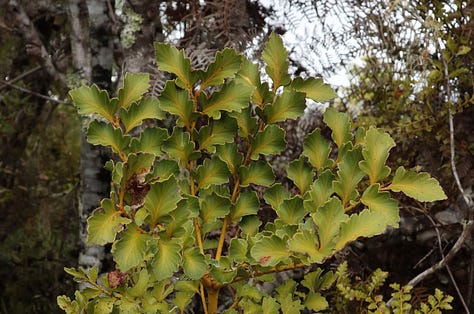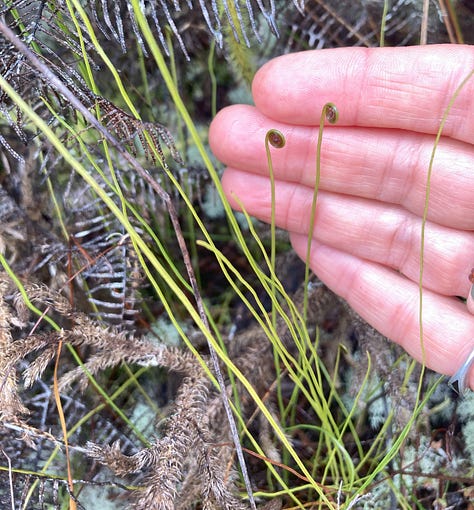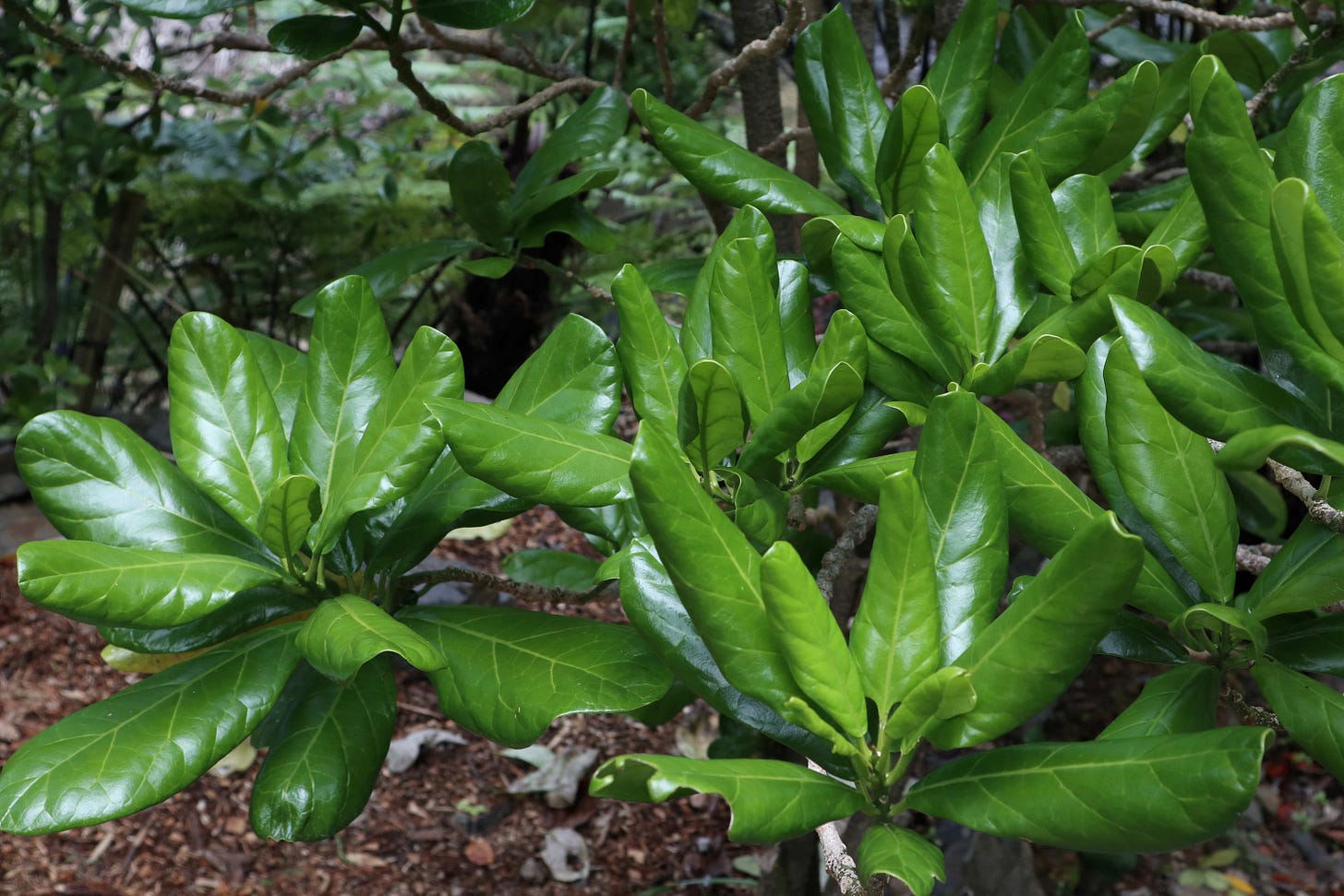On the precipice
The precarious position of New Zealand's rare plants (12 minute read)
A chorus of botanists on a field trip, chattering arcane-sounding Latin names, doesn’t sound much like music. To me, though, it’s a sound as uplifting as any rousing chorus. Think of Handel’s Hallelujah chorus, only instead of Hallelujah, Hallelujah, it’s Pomaderris amoena or Thelymitra ixioides. Someone at the head of the group might spot something interesting, and they’ll stop to discuss the hairs on the sepals or the shape of the stipules with those nearest to them. If the plant is particularly hard to spot, someone might wait when the rest move on, to point it out to those who are ambling along behind. Sometimes, someone will mention the person who originally taught them to identify the plant being discussed, and then anecdotes about venerated mentors will be shared.
It's almost 20 years since I was a professional botanist and slightly longer since I was an active member of my local botanical society. I didn’t stop because I didn’t enjoy it. My decision was primarily economic – I wanted greater job and financial security, and botany didn’t offer that. I also wanted to live in Wellington, which felt like home within a few months of me moving there. I hadn’t felt that way about Christchurch or Nelson, where I’d lived previously. I didn’t even feel like that about Auckland, and I grew up there.
Over the last week, though, I’ve been reminded of what I gave up back then. I’ve been in Whangārei, attending the biennial conference for the New Zealand Plant Conservation Network. I knew about the network largely because it maintains an excellent collection of native (and some non-native) plant photos on its website. However, until earlier this year I had never joined and had never been to a conference. When I did decide to join, I noticed that they were holding a conference in Whangārei later in the year. I looked at the programme and decided that it was both relevant to the work I’m doing and a great opportunity to catch up with people I hadn’t seen in a long time. I also knew that Northland has many fascinating plants and places. I decided to go.
When I worked as a botanist, the focus of my work wasn’t plant conservation, but plant killing, because I worked with weeds. However, the two are closely connected. Nobody who works on weeds (or any invasive species) advocates killing them just because they aren’t native, or even because they are invasive, at least nobody I have encountered. Sometimes it sounds as if they are, because people can be careless in how they describe their work. Scientists, I’ve noticed, are sometimes careless in describing their research too, especially if all the work they do is on the most damaging invasive species. But I worked as an adviser to those who made the decisions about which plants were killed and which were not, as well as those who paid for the work. They understood that the goal was not killing but protecting something – usually a rare native species or community of plants and animals. The most important part of my work was identifying which of the many non-native plants were causing harm, and precisely where controlling them would protect other plants and animals.
When one species is prioritised over another, there’s always scope for debate, because the decision is a matter of value, not a matter of fact. But the decisions aren’t arbitrary – there are reasons behind them. I was reminded of these reasons as I listened to the speakers at the Plant Conservation Network conference. I learned, too, that the situation for some of our rare plants was much more dire than I had imagined.
There are slightly different views on exactly how many plant species are native to New Zealand, depending on how they are counted. The most common figures quoted are in the range 2000-2500. This covers flowering plants (including those with inconspicuous flowers, such as grasses) and conifers such as the mighty kauri tree. The larger figures also include ferns. But these numbers miss many of the less conspicuous species. We have nearly 500 mosses, and over 600 species which belong to a related group known as liverworts. We also have thousands of species of algae and lichens – it’s debatable whether all of these are strictly plants, but we certainly have a lot of them.
Most of New Zealand’s plants are found nowhere else. Of the flowering plants, conifers and ferns, around 80% are unique to New Zealand, and some are confined to very small areas, such as a single island or mountaintop. The figures are lower for mosses (20%) and liverworts (30%), but this is still substantial. If we lose one of our plant species, it is most likely lost to the world.
A group of expert botanists, many of whom were at the conference I attended, meet every few years to review which species of plant are under threat, and just how serious the threats are. The same process happens for other groups – birds, insects, slugs and snails, fish, bats, fungi, even mites and ticks. They use a manual, updated every ten years or so, which gives criteria for defining whether or not a species is under threat, and what degree of threat they face. The majority of plant species, fortunately, receive a classification of not threatened. In this, plants are luckier than fish, where only a third are not threatened; birds, where around a quarter of surviving species are not threatened; reptiles and carnivorous snails, where fewer than 10% are not threatened; or bats and frogs, where all are threatened. Nonetheless, New Zealand still has hundreds of plants which are under threat.
Among those species which are under threat, there are two broad categories, each with sub-categories. Those which are in the most danger are classed as threatened, while those which are still of concern but not in so much trouble are at risk. Among the species classed as threatened, the ones in the most desperate straits are classified as nationally critical. This is the group that includes birds such as the kākāpō and the black robin. There are around 200 plants in this group. Not all are species – some are varieties which aren’t distinct enough to be classed as species. Even so, that’s a lot of plants in deep, deep trouble. And I realise how little I know about them, despite my passion for plants.
What has brought so many plants to the brink of extinction? With our birds, there’s one cause which stands out above all others – introduced mammal predators. With plants, the threats are usually more diverse. Each one is slightly different too. There’s no single answer to save them.
The best known of our critically endangered plants must be the ngutukākā or kākā beak. There are actually two separate species – one with fewer than 100 wild plants and the other with only one wild plant left. Ngutukākā, with its spectacular red flowers, is commonly cultivated. But that’s not the same as having wild plants in their natural habitat, especially because garden plants are mostly grown from cuttings. The thousands of plants in New Zealand gardens don’t have the same natural variation which the wild plants would have had. The most obvious problem for ngutukākā is that everything likes to eat it – goats, deer, hares, pigs, wandering livestock and even introduced snails. As a result, it’s now mostly confined to inaccessible areas such as steep cliffs. It’s also a species which naturally grows in disturbed habitats, such as where there has been a slip. But many introduced plants, such as fast-growing grasses introduced for pasture, as well as species such as gorse, also grow well in such places, so it faces much more competition than it did in the past. Even if it wasn’t struggling against weeds, ngutukākā would eventually be overtaken by taller-growing native species. It’s not a species which lives for a long time in one place. When New Zealand was a land of native forest browsed by moa and kākāpō and giant wētā, that strategy worked perfectly well. Now, with humans dominating most of the landscape, we simply haven’t left enough space for ngutukākā to move around. There are people trying to save it – there’s a great article about some of that work here – but it isn’t clear whether their efforts will ensure its survival in the wild.
Another species almost eaten to extinction by introduced mammals is the kaikōmako Manawatāwhi. To the north-east of Cape Reinga, there is a group of islands which I learned as the Three Kings Islands, but their original name was Manawatāwhi. The islands were devastated when goats were released there in 1889, and by the time they were removed fifty years later, only a single tree of kaikōmako Manawatāwhi remained, on a precipitous cliff. Like ngutukākā, it really was in a precarious position. The situation was even more grim than it first appeared, because kaikōmako Manawatāwhi is a species which has, or rather had, separate male and female plants. The remaining tree was a female, and without a male would be unable to produce seed. The only hope was to take cuttings.
A few plants were established in Mt Albert, at what was then the Department of Scientific and Industrial Research. By applying plant hormones, botanists persuaded the plants to produce a few seeds. One of the plants they managed to grow was, unexpectedly, able to produce further seeds, making the prospect of propagating many more plants possible.
There’s much more to the story, and it’s far from over, but kaikōmako Manawatāwhi might just turn out to be a plant which comes back from the brink (if you want to know more, I have linked to a lovely video about it here).
But kaikōmako Manawatāwhi is a rarity in more ways than one. Few of New Zealand’s most threatened species have the prospect of such a good outcome. Many may cross the threshold to extinction in the wild in the next few years, and few will know of their passing. One such species is the coastal peppercress. It’s a small coastal herb, related to the plant known as Cook’s scurvy grass, although neither is a grass. They are members of the cabbage or brassica family, and this is part of their problem. We have, quite unintentionally, introduced a wide range of pests and diseases which live on various kinds of brassica. Many of these are happy to munch on coastal peppercress too. As a result, it’s not a species which can be easily grown in gardens, as both ngutukākā and kaikōmako Manawatāwhi can.
Coastal peppercress is also vulnerable to the usual problems facing our rare plants – being eaten by introduced mammals and competition with fast-growing weeds. Because it’s such a small plant (in fact many of our rarest plants are) it doesn’t take much to eat it away to nothing or to smother it. There’s another problem it faces as well. Coastal areas around New Zealand were once home to staggering numbers of seabirds. They would spend most of their time on the ocean but would breed on land. When they did, their excrement fertilised the ground, making the plants grow lush and thick. But coastal development and introduced predators mean that we don’t have these huge flocks of seabirds bringing nutrients from the sea to the land anymore.
If it wasn’t for the efforts of two botanists from the Department of Conservation, there’s little doubt that coastal peppercress would be extinct by now. They have worked on finding populations of the plant, as well as ways to establish plants in the wild. Planting seedlings or mature plants wasn’t effective, but if a suitable site was prepared correctly seed could be sown and this did result in plants establishing. Today, most of the remaining hundred or so plants were planted in this way.
There’s a common thread in all of these plant stories, and it links back to the reason that a chorus of botanists brings me such joy. None of these species would be surviving without the dedicated efforts of a small group of people who have worked to save them. For each species, there are one or two people whose work has made the difference between precarious survival and extinction.
I’ve worked with many of these people over the years, and I met more at the conference. A few would be classed as research scientists, and work at research institutes or universities – or they did before retiring. Others have worked for the Department of Conservation, and a few in local government. They are hugely knowledgeable people, true experts with decades of experience. They don’t simply know a huge number of plants, they understand how the plants interact with the environment. By doing this, they can predict the kinds of places to look for new plants of these most endangered species. They also see things that other people might overlook. A few years ago, these skills led to the rediscovery of a plant which had been believed extinct for decades.
This isn’t the kind of knowledge which comes from academic study, even though that is a useful foundation. It’s a knowledge which develops from working with more experienced botanists and years of careful observation of plants in the wild. It’s not pure science, but a deep understanding of the natural world.
Despite their outstanding expertise, the people I know with this kind of knowledge have always been humble and patient with those less expert than themselves, such as me. They learned from great mentors, and in turn became wonderful mentors themselves. It was clear to me at the Plant Conservation Network conference that they have done an outstanding job. I encountered the next generation of dedicated botanists, people in their 20s and 30s who have already developed formidable expertise. They are as dedicated as previous generations in their commitment to protecting New Zealand’s overlooked endangered plants. There are so many things acting against our native plants, but one thing in their future is certain. They will have great people fighting for their survival.








It's very similar here in San Diego County, California. We have dozens of rare and endangered plants, many of which grow nowhere else.
What an interesting price of writing . Thanks Melanie . I have lots of ferns and mosses coming thru in my now free from sheep little Totara tree block . I must photograph them and try to identify them
I wonder if you visited Tawapo native plant place near Tutukaka . .. A wonderful pair of knowledgeable botanists ..doing great work . (and beautiful sculptors to look at too ) .
love your work .😊